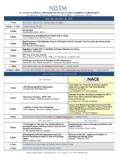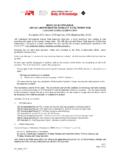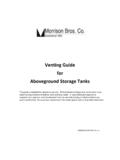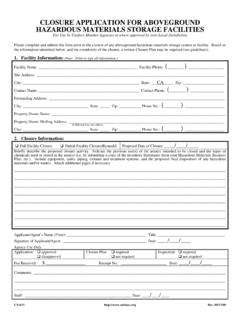Transcription of Technical Requirements for Aboveground Storage ... - CIMICO
1 H:\My Documents\ Technical References\Comm 10 Class IIIB Tank 1 of 5 Technical Requirements for Aboveground Storage Tanks (ASTs) Storing Class IIIB Liquids (other than used oil) References: Comm 10 2009 EDITION / NFPA 30 2008 EDITION ITEM DESCRIPTION Comm 10 / NFPA General Class IIIB AST Requirements FLASH POINT Comm (30) Combustible Liquid, (30) Combustible liquid means a liquid having a flash point at or above 100 F. Note: Under NFPA 30 section , combustible liquids are further classified as being Class II, IIIA or IIIB liquids. NFPA Combustible liquids, as defined in and , shall be classified in accordance with the following: (1) Class II Liquid Any liquid that has a flash point at or above 100 F ( C) and below 140 F (60 C) (2) Class III Liquid Any liquid that has a flash point at or above 140 F (60 C) (a) Class IIIA Liquid Any liquid that has a flash point at or above 140 F (60 C), but below 200 F (93 C) (b) Class IIIB Liquid Any liquid that has a flash point at or above 200 F (93 C) Flash point identified on the Material Safety Data Sheet (MSDS) is the reference.
2 DEFINED AND REGULATED AS A COMM 10 TANK Comm 10 effective July 2002 Exempt: UST less than 60 gal. AST less than 110 gal. PLAN REVIEW Requirements Required for all USTs; and ASTs larger than 1,100 gallon capacity. Comm (1)(b)3 exemption: Aboveground tanks which have a capacity of less than 1,100 gallons and which store Class IIIB liquids other than used oil. REGISTRATION Requirements Required for all USTs and ASTs larger than 1,100 gallon capacity. Comm (1)(a)3 exemption: ASTs used to store Class IIIB liquids other than used oil. CONSTRUCTION STANDARD Listing: Comm (1) (c) Tanks for Class IIIB liquids. Tanks of 1,100 gallon or more capacity used for Aboveground Storage of Class IIIB liquids shall be listed or shall be acceptable to the department. (Accepted listings in note below) [Therefore, tanks less than 1,100 gallon capacity do not have a listing requirement.]
3 Acceptable to the department are typically tanks that are manufactured (not owner fabricated) by a recognized tank manufacturer for the intended Storage purpose.] Comm (2) CONSTRUCTION. (a) Except as allowed under par. (b), tanks containing flammable or combustible liquids shall be constructed to one of the recognized design standards in NFPA 30 or a standard approved by the department. Note: Design standards recognized by NFPA 30 include API 12B, API 12D, API 12F, API 620, API 650, UL 58, UL 80, UL 142, UL 1316, UL 1746, UL 2080, UL 2085 and UL 2386. IBCs UL 2386 is the fire exposure test standard for IBC rated/approved for combustible liquid handling. The UL mark states specifically: "These Requirements cover intermediate bulk containers (IBC's) intended for the Storage of flammable and combustible liquids within warehouses and other Storage areas protected with automatic wet-pipe sprinkler systems.
4 " NFPA 30 Chapter 4 addresses IBCs up to 800 gallon INSTALL BY CERTIFIED CONTRACTOR Tanks that do not require Comm 10 plan review are not required to be installed by a Comm 5 certified contractor. H:\My Documents\ Technical References\Comm 10 Class IIIB Tank 2 of 5 ANNUAL INSPECTION No TANK DESIGN & CONSTRUCTION Requirements (CONSTRUCTION MATERIAL) Comm Tank construction and marking. (2) CONSTRUCTION. Tanks containing flammable or combustible liquids shall be constructed to one of the recognized design standards in NFPA 30 section , or to another standard or design approved by the department, .. NFPA 30- Materials of Construction. Tanks shall be of steel or other approved noncombustible material and shall meet the applicable Requirements of through The materials of construction for tanks and their appurtenances shall be compatible with the liquid to be stored.
5 In case of doubt about the properties of the liquid to be stored, the supplier, producer of the liquid, or other competent authority shall be consulted. Tanks shall be permitted to be constructed of combustible materials only when approved by the authority having jurisdiction. Tanks constructed of combustible materials shall be limited to the following: (1) Underground installation (2) Use where required by the properties of the liquid stored (3) Aboveground Storage of Class IIIB liquids in areas not exposed to a spill or leak of Class I or Class II liquid (4) Storage of Class IIIB liquids inside a building protected by an approved automatic fire-extinguishing system. Unlined concrete tanks shall be permitted to be used for storing liquids that have a gravity of 40 API or heavier.
6 Concrete tanks with special linings shall be permitted to be used for other liquids, provided they are designed and constructed in accordance with recognized engineering standards. NFPA Design Standards for Atmospheric Tanks. Atmospheric tanks, including those incorporating secondary containment, shall be designed and constructed in accordance with recognized standards or approved equivalents. Atmospheric tanks that meet any of the following standards shall be deemed as meeting the Requirements of API 12B, API 12D, API 12F, API 650, UL 80, UL 142, UL 2080 and UL 2085 Comm (1)(c) Tanks for Class IIIB liquids. Tanks of 1,100 gallon or more capacity used for Aboveground Storage of Class IIIB liquids shall be listed or shall be acceptable to the department TANKS IN BUILDINGS NFPA 30-24 shall apply to installations of tanks storing Class I, Class II, and Class IIIA liquids in Storage tank buildings.
7 This subsection shall not specifically apply to such tanks in process areas. (See Chapter 7.) NFPA storing Class IIIB liquids are not be required to comply with the provisions of this subsection. However, adequate space must be provided for both tank and building maintenance. A tank installation that has a canopy or roof that does not limit the dissipation of heat or dispersion of flammable vapors and does not restrict fire-fighting access and control shall be treated as an outside Aboveground tank. TANK SPACING TANK-TO-TANK NFPA Shell to shell spacing between any two adjacent Aboveground tanks. Tanks storing Class I, II, III stable liquids shall be separated by the distances given in Table [Table at end of document.] Exception: Tanks used only for storing Class IIIB Liquids need not be separated by more than 3 feet provided they are not within the same diked area as or drainage path of a tank storing a Class I or II liquid.
8 TANK TO PROPERTY LINE THAT CAN BE BUILT UPON AND TANK FROM IMPORTANT NFPA Tanks storing Class IIIB stable liquids shall be located in accordance with Table Exception: If located within the same diked area as or the drainage path of a tank H:\My Documents\ Technical References\Comm 10 Class IIIB Tank 3 of 5 BUILDING storing a Class I or Class II liquid, the tank storing Class IIIB liquid shall be located in accordance with NFPA 30 TABLE CLASS IIIB LIQUIDS. [Table at end of document.] NOTE: For tanks used for vehicle fueling refer to NFPA 30A. COLLISION PROTECTION Yes - NFPA OVERFILL PROTECTION Refer to NFPA A sight gauge is acceptable for Class IIIB liquid Storage . SECONDARY CONTAINMENT SPILL PREVENTION No - Not required for Class IIIB liquids - NFPA 30- Control of spills from Aboveground tanks.
9 Every tank that contains a Class I, Class II, or Class IIIA liquid shall be provided with means to prevent an accidental release of liquid from endangering important facilities and adjoining property or from reaching waterways. NOTE: Federal EPA SPCC regulations require containment if the tank is within the scope of SPCC. The current scope of SPCC includes oils that originate from vegetable and animal sources, as well as petroleum oils. FOUNDATION SUPPORTS AND PROTECTION NFPA Tanks shall rest on the ground or on foundations made of concrete, masonry, piling, or steel. Tank foundations shall be designed to minimize the possibility of uneven settling of the tank and to minimize corrosion in any part of the tank resting on the foundation. Where tanks storing Class I, Class II, or Class IIIA liquids are supported above their foundations, tank supports shall be of concrete, masonry, or protected steel.
10 PIPING SYSTEMS NFPA 30-Chapter 3 Piping Systems. This chapter shall apply to piping systems consisting of pipe, tubing, flanges, bolting, gaskets, valves, fittings, flexible connectors, the pressure-containing parts of other components such as expansion joints and strainers, and devices that serve such purposes as mixing, separating, snubbing, distributing, metering, controlling flow, or secondary containment of liquids and associated vapors. ANTI SYPHON NFPA Means shall be provided to prevent the release of liquid from the tank by siphon flow. NORMAL VENTING (ATMOSPHERIC) Yes NFPA 30 Atmospheric Storage tanks shall be adequately vented to prevent the development of vacuum or pressure that can distort the roof of a cone roof tank or that exceeds the design pressure of other atmospheric tanks when filling or emptying the tank or because of atmospheric temperature changes.







